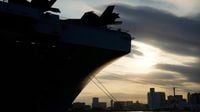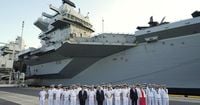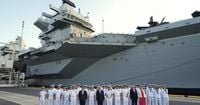On August 28, 2025, Tokyo’s port played host to a striking symbol of deepening international cooperation: the Royal Navy’s HMS Prince of Wales, flanked by a 12-nation carrier strike group, docked for the first time in the Japanese capital. The event, hailed by both Japanese and British defense ministers as a milestone in their countries’ relationship, underscores a shift in the security landscape of the Indo-Pacific and marks the first time a foreign aircraft carrier has visited Tokyo—a fact that did not go unnoticed by the assembled dignitaries and media.
At the heart of the celebration were two men: UK Defense Secretary John Healey and Japan’s Defense Minister Gen Nakatani. They met at Japan’s Defense Ministry, exchanging words that reflected a new era for their nations’ partnership. According to the Associated Press, Healey remarked, “We are proud to be taking our air and our naval cooperation now to new levels.” His Japanese counterpart echoed this sentiment, stating, “Japan and the U.K. are the closest security partners in Asia and Europe and we have steadily enhanced cooperation. I’m extremely happy to share this historic moment when Japan-U.K. defense cooperation has reached a new level.”
The HMS Prince of Wales isn’t just any warship. As the flagship of a multinational carrier strike group with 4,000 servicemembers, its arrival in Tokyo is more than a port call; it’s a message. The eight-month deployment throughout the Indo-Pacific is part of a broader UK strategy to bolster its presence—both economically and militarily—in a region increasingly seen as pivotal to global stability. As reported by ABC and the Associated Press, the UK’s engagement is designed to reinforce alliances and demonstrate commitment to upholding the rules-based international order.
This growing partnership is not limited to ceremonial visits or joint exercises. At the press conference, Healey and Nakatani reaffirmed their commitment to an ambitious joint project: the Global Combat Air Program (GCAP), a trilateral initiative with Italy. The goal? To develop a next-generation fighter jet by 2035. The program, as outlined by both ministers in a joint statement, aims to “sustain national airspace sectors, maximize emerging technologies to meet any future threats and protect critical industries.” The ministers underscored their intent to accelerate negotiations and sign the first international contract for the project by the end of 2025—a timeline that signals urgency and shared resolve.
The GCAP is more than a technical collaboration; it’s a strategic hedge against an evolving security environment. Japan, long reliant on the United States as its principal security ally, has been seeking to diversify its defense partnerships. This recalibration comes amid mounting concerns over China’s growing assertiveness in the region. The Associated Press notes that Japan’s efforts to expand its network of security relationships are part of a broader deterrence strategy. The UK, for its part, sees its role in the Indo-Pacific as a natural extension of its global responsibilities, a sentiment echoed by Healey: “The strategic cooperation with Japan is part of the U.K.'s commitment to be more engaged in the economy and security in the Indo-Pacific.”
Recent multinational naval exercises in the region have provided concrete examples of this cooperation in action. In a notable first, a British F-35B fighter jet landed on the deck of the JS Kaga, one of Japan’s two aircraft carriers central to its ongoing military buildup. This event, reported by multiple outlets, is emblematic of the practical interoperability that both nations are striving for. It’s not just about technology, but about building trust, routines, and capabilities that can be called upon in times of crisis.
For Japan, the arrival of the HMS Prince of Wales and the deepening of ties with the UK represent a significant evolution in its defense posture. Traditionally, Japan’s security policy has been closely aligned with that of the United States, but the shifting dynamics of the Indo-Pacific—marked by territorial disputes, increased military spending, and the specter of gray-zone conflicts—have prompted Tokyo to look for additional partners. The UK, with its historical ties to the region and its renewed interest in global engagement post-Brexit, is an attractive and capable ally.
The symbolism of the HMS Prince of Wales’ visit is not lost on observers. It’s a visible demonstration of the UK’s willingness to project power far from home and to back up diplomatic commitments with military assets. For Japan, it’s a statement of intent: a signal that it is ready to play a more proactive role in regional security, working with like-minded partners to uphold peace and stability.
This alignment is not without its challenges. The trilateral fighter jet project, while promising, will require significant coordination—not only between Japan and the UK, but also with Italy, the third partner in the GCAP. The partners must harmonize requirements, share sensitive technologies, and ensure that industrial interests are balanced. The ministers’ joint statement, as reported by the Associated Press, acknowledged these hurdles but expressed confidence that the project would “help sustain national airspace sectors, maximize emerging technologies to meet any future threats and protect critical industries.”
Meanwhile, the broader context of China’s regional ambitions looms large. While neither Healey nor Nakatani mentioned China explicitly in their public remarks, the subtext was clear. Japan’s efforts to strengthen its security ties beyond the US are widely understood as a response to Beijing’s growing military capabilities and assertiveness in the East and South China Seas. The UK’s increased engagement in the Indo-Pacific is similarly viewed as part of a collective effort among democracies to maintain a balance of power and deter unilateral changes to the status quo.
Looking ahead, the next steps for the Japan-UK partnership are clear: finalize the fighter jet contract, continue joint exercises, and expand cooperation in emerging domains such as cyber and space. But perhaps most importantly, both nations are signaling—to friends and rivals alike—that their alliance is more than words. It’s anchored in shared values, mutual interests, and a willingness to act together in defense of a free and open Indo-Pacific.
As the HMS Prince of Wales sailed into Tokyo Bay, it carried with it not only sailors and aircraft, but the weight of history and the promise of a new chapter in international security cooperation. For Japan and the UK, the visit marked a turning point—a moment when words were matched by deeds, and a partnership forged in the past was renewed for the challenges of the future.



